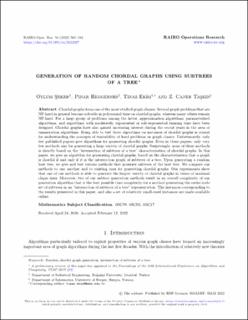| dc.description.abstract | Chordal graphs form one of the most studied graph classes. Several graph problems that are NP-hard in general become solvable in polynomial time on chordal graphs, whereas many others remain NP-hard. For a large group of problems among the latter, approximation algorithms, parameterized algorithms, and algorithms with moderately exponential or sub-exponential running time have been designed. Chordal graphs have also gained increasing interest during the recent years in the area of enumeration algorithms. Being able to test these algorithms on instances of chordal graphs is crucial for understanding the concepts of tractability of hard problems on graph classes. Unfortunately, only few published papers give algorithms for generating chordal graphs. Even in these papers, only very few methods aim for generating a large variety of chordal graphs. Surprisingly, none of these methods is directly based on the “intersection of subtrees of a tree” characterization of chordal graphs. In this paper, we give an algorithm for generating chordal graphs, based on the characterization that a graph is chordal if and only if it is the intersection graph of subtrees of a tree. Upon generating a random host tree, we give and test various methods that generate subtrees of the host tree. We compare our methods to one another and to existing ones for generating chordal graphs. Our experiments show that one of our methods is able to generate the largest variety of chordal graphs in terms of maximal clique sizes. Moreover, two of our subtree generation methods result in an overall complexity of our generation algorithm that is the best possible time complexity for a method generating the entire node set of subtrees in an “intersection of subtrees of a tree” representation. The instances corresponding to the results presented in this paper, and also a set of relatively small-sized instances are made available online. | en_US |

